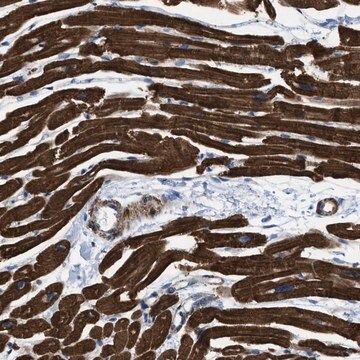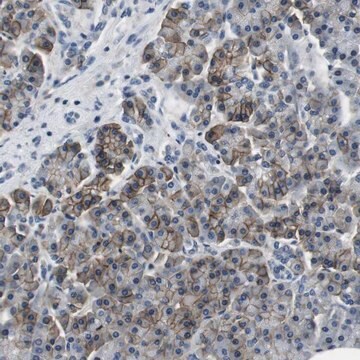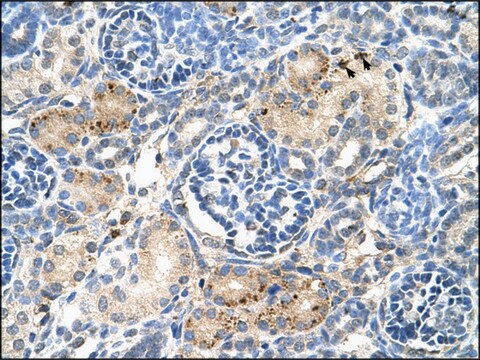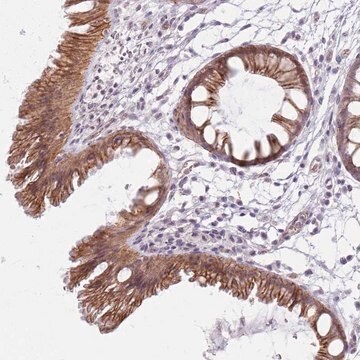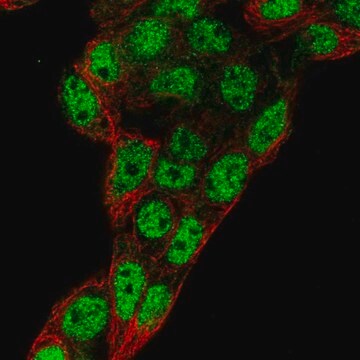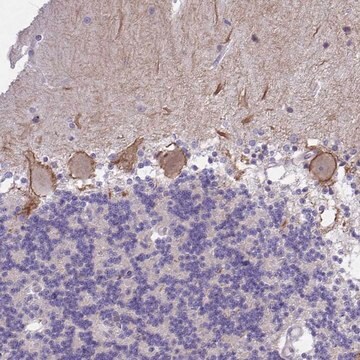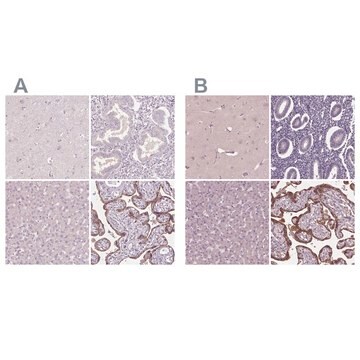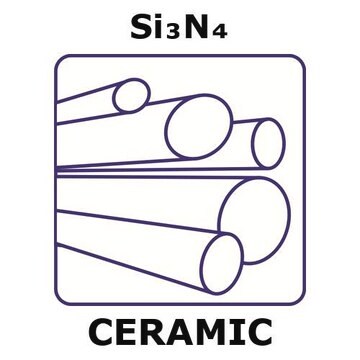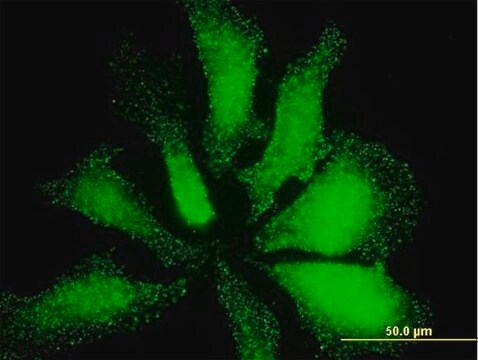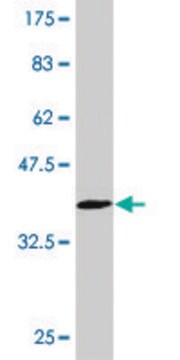HPA017353
Anti-KCNJ5 antibody produced in rabbit

Prestige Antibodies® Powered by Atlas Antibodies, affinity isolated antibody, buffered aqueous glycerol solution
同義詞:
Anti-CIR, Anti-GIRK4, Anti-KATP1, Anti-Kir3.4, Anti-LQT13
登入查看組織和合約定價
全部照片(7)
About This Item
共軛:
unconjugated
application:
IHC
無性繁殖:
polyclonal
物種活性:
human
citations:
6
技術:
immunoblotting: 0.04-0.4 μg/mL
immunohistochemistry: 1:200-1:500
immunohistochemistry: 1:200-1:500
推薦產品
生物源
rabbit
品質等級
共軛
unconjugated
抗體表格
affinity isolated antibody
抗體產品種類
primary antibodies
無性繁殖
polyclonal
產品線
Prestige Antibodies® Powered by Atlas Antibodies
形狀
buffered aqueous glycerol solution
物種活性
human
加強驗證
recombinant expression
orthogonal RNAseq
Learn more about Antibody Enhanced Validation
技術
immunoblotting: 0.04-0.4 μg/mL
immunohistochemistry: 1:200-1:500
免疫原序列
VTPWDPKKIPKQARDYVPIATDRTRLLAEGKKPRQRYMEKSGKCNVHHGNVQETY
UniProt登錄號
運輸包裝
wet ice
儲存溫度
−20°C
目標翻譯後修改
unmodified
基因資訊
human ... KCNJ5(3762)
免疫原
G protein-activated inward rectifier potassium channel 4 recombinant protein epitope signature tag (PrEST)
應用
Applications in which this antibody has been used successfully, and the associated peer-reviewed papers, are given below.
Immunohistochemistry (1 paper)
Immunohistochemistry (1 paper)
特點和優勢
Prestige Antibodies® are highly characterized and extensively validated antibodies with the added benefit of all available characterization data for each target being accessible via the Human Protein Atlas portal linked just below the product name at the top of this page. The uniqueness and low cross-reactivity of the Prestige Antibodies® to other proteins are due to a thorough selection of antigen regions, affinity purification, and stringent selection. Prestige antigen controls are available for every corresponding Prestige Antibody and can be found in the linkage section.
Every Prestige Antibody is tested in the following ways:
Every Prestige Antibody is tested in the following ways:
- IHC tissue array of 44 normal human tissues and 20 of the most common cancer type tissues.
- Protein array of 364 human recombinant protein fragments.
聯結
Corresponding Antigen APREST72858
外觀
Solution in phosphate-buffered saline, pH 7.2, containing 40% glycerol and 0.02% sodium azide
法律資訊
Prestige Antibodies is a registered trademark of Merck KGaA, Darmstadt, Germany
免責聲明
Unless otherwise stated in our catalog or other company documentation accompanying the product(s), our products are intended for research use only and are not to be used for any other purpose, which includes but is not limited to, unauthorized commercial uses, in vitro diagnostic uses, ex vivo or in vivo therapeutic uses or any type of consumption or application to humans or animals.
未找到適合的產品?
試用我們的產品選擇工具.
儲存類別代碼
10 - Combustible liquids
水污染物質分類(WGK)
WGK 1
閃點(°F)
Not applicable
閃點(°C)
Not applicable
個人防護裝備
Eyeshields, Gloves, multi-purpose combination respirator cartridge (US)
Chih-Jen Cheng et al.
The Journal of clinical endocrinology and metabolism, 100(1), E155-E163 (2014-10-28)
Aldosterone-producing adenoma (APA) has been linked to mutations in the KCNJ5 gene encoding the inward-rectifying potassium (K(+)) Kir3.4 channel. These mutations abolish the K(+) selectivity of Kir3.4 and, consequently, cause sodium (Na(+)) leak, depolarized membrane potential, and nonsuppressible aldosterone secretion.
Elena A B Azizan et al.
Nature genetics, 45(9), 1055-1060 (2013-08-06)
At least 5% of individuals with hypertension have adrenal aldosterone-producing adenomas (APAs). Gain-of-function mutations in KCNJ5 and apparent loss-of-function mutations in ATP1A1 and ATP2A3 were reported to occur in APAs. We find that KCNJ5 mutations are common in APAs resembling
Elena A B Azizan et al.
The Journal of clinical endocrinology and metabolism, 97(5), E819-E829 (2012-03-24)
Aldosterone-producing adenomas (APA) are heterogeneous. The recent finding of somatic KCNJ5 mutations suggests a genetic explanation. The objectives of this study were the following: 1) to compare transcriptional profiles in APA and adjacent adrenal gland (AAG); 2) to test whether
Junhua Zhou et al.
Hypertension (Dallas, Tex. : 1979), 65(5), 1103-1110 (2015-03-18)
Common somatic mutations in CACNAID and ATP1A1 may define a subgroup of smaller, zona glomerulosa (ZG)-like aldosterone-producing adenomas. We have therefore sought signature ZG genes, which may provide insight into the frequency and pathogenesis of ZG-like aldosterone-producing adenomas. Twenty-one pairs
Carmela Maniero et al.
Hypertension (Dallas, Tex. : 1979), 70(2), 357-364 (2017-06-07)
Heterogeneity among aldosterone-producing adenomas (APAs) has been highlighted by the discovery of somatic mutations. KCNJ5 mutations predominate in large zona fasciculata (ZF)-like APAs; mutations in CACNA1D, ATP1A1, ATP2B3, and CTNNB1 are more likely to be found in small zona glomerulosa
我們的科學家團隊在所有研究領域都有豐富的經驗,包括生命科學、材料科學、化學合成、色譜、分析等.
聯絡技術服務